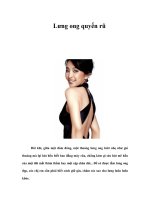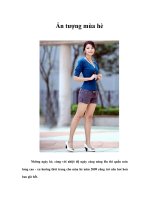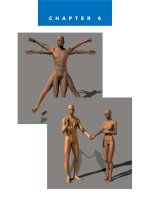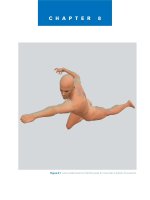Tài liệu Figure Drawing - Figure Construction pptx
Bạn đang xem bản rút gọn của tài liệu. Xem và tải ngay bản đầy đủ của tài liệu tại đây (697.03 KB, 16 trang )
CHAPTER 2
Figure 2.1 Use a simplified skeleton like the one shown here to start your drawing.
Figure Construction
✎
17
I
n this chapter I will cover how to construct the figure using some sim-
plified methods to make the process of drawing a little easier. I will start
by showing you how to build a simple structure as the basis for defining
dimension and proportion. This structure will become the foundation of your
figure drawings. You will then be able to use it to develop a finished figure
drawing.
Drawing from the Inside Out
At the beginning of every figure drawing, the artist is faced with a daunting task in
defining a subject that is painfully complex yet supremely organized. Without ini-
tially simplifying the figure, the artist may become overwhelmed.
It is very important in the initial stages of a figure drawing to be able to use some
kind of simple framework to define the dimensions and proportions of the figure
on the paper. The artist needs a simple and accurate system for starting the figure
on paper without getting bogged down in too much detail. One way of doing this
that works well for me is to go back to the foundation of the figure itself and draw
a simplified skeletal structure. Figure 2.1 shows a simplified skeleton; notice that
it isn’t too much more complex than a simple stick figure.
18
Figure Drawing with Virtual Models
The simplified skeleton should be
proportionally correct, as shown in
Figure 2.2, where I have overlaid
the same proportion chart used in
Chapter 1.
This simplified figure is very useful
in roughing out figures and figur-
ing out compositions. It is easy to
draw and doesn’t get bogged down
in detail. Here is an example of
how you can use it in conjunction
with Figure Artist.
Figure 2.2 Make your skeleton the correct proportions.
19
Figure Construction
STEP-BY-STEP
1
Start by creating a pose in Figure Artist, simi-
lar to the one shown in Figure 2.3.
2
Using the posed figure for a reference, start
with the figure’s ribcage by drawing a simple
oval with a few lines to indicate the front of
the ribcage and the overlying pectoral mus-
cles, as shown in Figure 2.4.
Figure 2.3 Pose and render a figure from Figure
Artist.
3
Next draw a line for the spine and
attach another oval for the head, as
shown in Figure 2.5.
4
At the base of the spine, draw a
block for the hips, as shown in
Figure 2.6. The hips will usually be
rotated from the ribcage because the
back is flexible and the lower part of
the human torso usually counterbal-
ances the upper torso.
Figure 2.4 Start
by drawing an
oval for the
ribcage.
Figure 2.5 Add
the spine and
head to your
drawing.
Figure 2.6 Draw
the hips next.
20
Figure Drawing with Virtual Models
Figure 2.7 Draw the legs and arms of the figure. Figure 2.8 Draw in the hands, feet, and knees.
7
The last step is to draw simple shapes for the
hands, feet, and knees, as shown in Figure
2.8.
5
Now draw lines indicating the shoulders and
arms across the top of the ribcage.
6
Draw the legs coming down from the hips, as
shown in Figure 2.7.
21
Figure Construction
The skeleton that you just drew
should fit over the top of the fig-
ure, as shown in Figure 2.9. In
fact, a useful exercise for beginning
artists is to use a piece of tracing
paper and define the skeleton of
photographs from magazines and
other sources.
The nice part about drawing the
skeleton first is that you can use it
to create a number of very expres-
sive figures in very little time.
Gesture
Drawing
One of the most important aspects
of learning to draw the figure is
getting the feeling of life and action
in your drawings, as shown in
Figure 2.10. This is often referred
to as capturing a gesture or gesture
drawing.
Gesture drawing is the foundation
of good figure drawing. A gesture
drawing is a quick drawing of the
figure focusing on just the figure’s
action. It doesn’t need to be accu-
rate, but it does need to get the
feeling of life and movement that is
inherent in any figure.
Figure 2.9 The skeleton and figure should match up
with each other.
Figure 2.10 The skeleton can show action.









